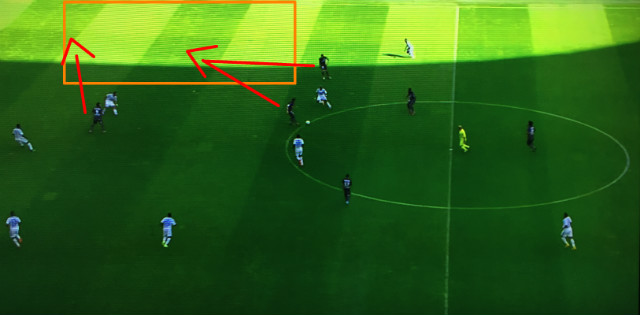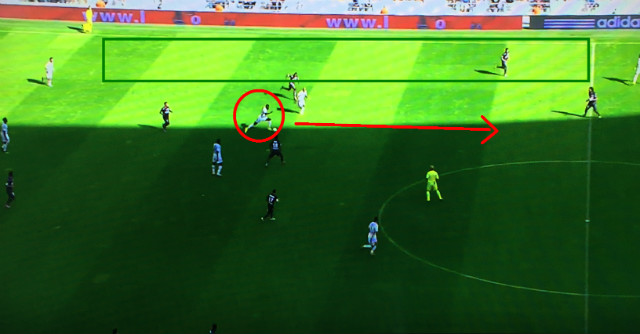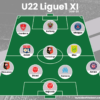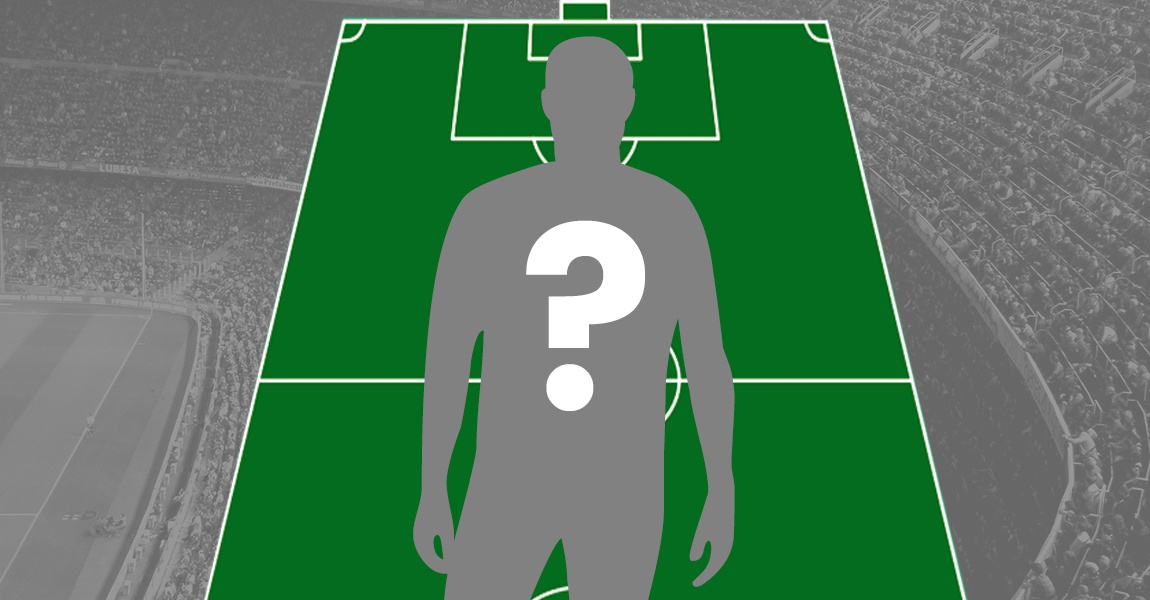The 2013/14 Ligue 1 campaign saw Marseille place 6th, 29 points off the champions PSG. A managerial change was brought when the season ended and in came El Loco, Marcelo Bielsa. Currently Marseille sit pretty atop the Ligue 1 table. Hamoudi Fayad tactically analyses the new Marseille under the Chilean perfectionist.

It’s good to see Marcelo Bielsa in another nation, setting out his ideas where inevitably someone in France will follow. French football has long been a football league system that has been so close – but so far – from threatening the top 3 European Nations (England, Germany/Italy, Spain) for the coveted “top four” Champions League places.
‘El Loco’ is aiming to return Olympique Marseille back to the UEFA Champions League and the summit of French football by battling gargantuan money spenders, PSG and Monaco. They will also be fighting for the top 3 places with Lyon and Bordeaux, who have also suffered since the arrival of PSG and Monaco on the title scene.
Marcelo Bielsa’s pressing system at Marseille against Roger Schmidt’s pressing system at Bayer Leverkusen, what differentiates one pressing system from another?
Pressing Shapes, Triggers, Dynamics, Pros and Cons (3-3-1-3)
Marseille use a zonal type of pressing and avoid using the ‘gegen’ or counter pressing that German teams love to use. Marseille shaped up against Toulouse with a 3-3-1-3, as Toulouse played with Wissam Ben Yedder and Martin Braithwaite up top in a 3-5-2. This is something we know that Marcelo Bielsa does, favoring the spare man system at the back. With 2 of the 3 centre backs acting like stoppers, there will be one to sweep up behind them and be free of marking a striker.
Marseille start off in Phase 1 with passes between the centre backs and the defensive midfielder Gianelli Imbula (scout report here), before switching play to either flank, where Benjamin Mendy and Brice Dja Djedje either cut inside or aim to hit Andre-Pierre Gignac with crosses from the byline. The philosophy at Marseille is: 4 defenders, and 6 attackers. The ambition is to hit other teams on the counter attack so that they’re unprepared while transitioning back to defense, and this was evident in both of Marseille’s goals against Toulouse.

Here is the build-up to Marseille’s 2nd goal. They have transitioned quickly from defense to attack and have 4 runners into the box with Imbula and Dja Djedje patrolling from deep. Mendy crosses the ball in and the Toulouse defenders are pressured into mistakes, which gives a free shot to Gignac.
Their first goal was similar, although Andre Ayew was fouled on the edge of the box while counter attacking into heaps of space, which resulted in a Marseille free kick. The ‘tactical foul’ from Toulouse led to a goal from Nicolas N’koulou, who put Marseille 1-0 up after turning brilliantly to score a header.
The excitement that their attack provides is fantastic, as you have many options. Hold up play from Gignac, cutting inside from the inverted wingbacks and Dimitri Payet, running to the byline from Ayew & Florian Thauvin, and even interchangeability are many of the things that this Marseille attack can offer. Gianelli Imbula will sit in the centre of everything for Marseille – the nucleus – protecting the defense and circulating the ball if it comes back to him. Gignac also offers a lot of support in pressing and harrying the opposition.
Marseille do not counter press when they lose the ball, rather the man who just lost the ball (or the man in the specific zone) will aim to press the player on the ball. Marseille also focused on the right when pressing in this game, and this is evident in where they made (first half stats) 8 interceptions on the right (compared to 3 everywhere else), attempting 12 tackles on the right (compared to 7 everywhere else), and with them recovering the ball in the right side of their own half on many occasions. Dja Djedje (right wing back) also stayed deeper than Mendy (left wing back).

Here is one instance of Marseille pressing, as Toulouse play the ball out from the back. Toulouse are playing down the flanks which triggers Marseille to press, as we can see they’ve covered everyone except for the central defender (Dusan Veskovac) on the right of the screen. Marseille will press Toulouse into a) giving the ball back to Veskovac, or b) a direct ball, or c) a clearance.

Here, Marseille are pressing Toulouse on the flanks again. They’ve covered everyone man to man and have a 4-v-2 (while covering the midfielders behind them with their cover shadow) in the zone where the ball is. As you can see, at the middle left of the screen, we have the “spare man” or the “sweeper”.
The disadvantages of this specific system is evident when Marseille lose the ball and their wing-backs are high up the pitch as they end up having to get overloaded while getting counter attacked.

Here, Mendy and Dja Djedje (circled in red) were caught high up the pitch, and now Marseille are void in the full back positions. Any ball from Braithwaite to Ben Yedder or Trejo could cause problems to the Marseille defense.

Mendy shows great potential as an attacking wing-back, but his defensive duties are being neglected at times. He’s only 20, though, and will improve on his defensive responsibilities.
Half Spaces and Inverted Wing Backs
Inverted wing-backs are a combination of box-to-box midfielders and wing-backs, and it is one of the most tiring positions to play in in football. The job of an inverted wing back (think Lahm and Alaba under Guardiola) is to cut inside into the half spaces and link up with the wingers. It offers unpredictability and it takes meticulousness and precision to get it correct, something Bielsa is a master at.

Here, Mendy takes the ball inside and pushes forward while linking up with Ayew. If you took out the annotations and saw it in a normal match, immediately people would think that Mendy is a runner from deep, like a box-to-box midfielder rather than a wingback. The left flank is free (Payet is on the left flank but upfield) and the centre is now in Marseille’s favour as 4 players (plus Dja Djedje) are there.

Thauvin (circled in red) is a winger in this system, aiming to run to the byline (although he continuously switches roles with Dja Djedje) and cross the ball in or find the wing back running into space.
The aim against a 3-5-2 is to stretch it wide so you can find pockets of spaces in defense, and that is exactly what Marseille did here.
Original Shape of Marseille

These two photos (above and below) are from the game against Lyon, but they show the same concept. This is Marseille in their defensive shape, which is widely known as to be the formational shape.

We can see the 3 central defenders in the last line, shifting over to the right flank, where the play is (a disadvantage of a 3-man defense shape, as the space behind Ayew/Mendy is vacated). The next line of 3 is the two wingbacks + defensive midfielder, and the next line of 3 are the interchanging attacking midfielders. The final man on the edge of the screen is Gignac.
Interestingly, as I was watching this game I found out that the space behind their wing-backs is an actual problem and will be attacked by most teams. This GIF shows Lyon’s winning goal against Marseille the other week (albeit the goal itself not being shown) and you can see the space left behind Mendy, which led to the goal.
Tactically, Marcelo Bielsa is widely known as a perfectionist, inspiring plenty of coaches across the world and enthusiasts alike. With Marseille possessing a squad of talented youngsters, nothing can be better for their development than the guidance of the experienced Argentine. For the club as a whole in the short and long-term, the benefits will be more than evident.
Written by Hamoudi Fayad
- Hipster Guide 2016-17: Bayer Leverkusen’s tactics, key players and emerging talents - August 25, 2016
- Talent Radar: Saudi Pro League 10 Young Players (U-23) to Watch in 2016-17 - August 23, 2016
- Dry Grassroots: Youth Football Deficiencies in Western Asia - July 19, 2016

























































